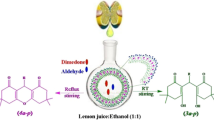Abstract
Starting from dehydrobaietic acid with the analogous structure of carnosic acid, the intermediate methyl 12-bromo-13-nitro-7-oxo dehydrodeisopropylabietate was synthesized through methylation, bromination, carbonylation, and nitration. Subsequently, the coupling of methyl 12-bromo-13-nitro-7-oxo dehydrodeisopropylabietate with aliphatic or aromatic primary amine by Ullmann condensation reaction produced a series of methyl 12-imino-13-nitro-7-oxo dehydrodeisopropylabietate derivatives. In order to probe their antioxidant effects through metal ion chelation mechanism, the metal ion binding abilities on Cu2+ and Fe2+ of these compounds were studied using fluorescence quenching method. The results indicated that each compound showed obvious chelation activity with the binding constants (K A) of the 102 L mol−1 order of magnitude, which implied its potential pharmacology application as antioxidant by the inhibition of Feton reaction through chelation with Cu2+ and Fe2+.




Similar content being viewed by others
References
Beatriz S, Guillermo SH (2005) Gastroprotective and cytotoxic effect of dehydroabietic acid derivatives. Pharmacol Res 52:429–437
Bermejo P, Pinñero E, Villar ÁM (2008) Ion-chelating ability and antioxidant properties of phycocyanin isolated from a protean extract of Spirulina platensis. Food Chem 110:436–445
Esteves AM, Narender N (2001) Synthetic derivatives of abietic acid with radical scavenging activity. J Nat Prod 64:761–763
Esteves MA, Narender N, Gigante B, Marcelo-Curto MJ, Alvarez A (1999) Bromination of resin acid derivatives. Syn Commun 29:275–287
Feio SS, Gigante B, Roseiro JC (1999) Method on multiwell plates for the evaluation of the antimicrobial activity of resin acid derivatives. J Microbiol Methods 35:201–206
Fonseca T, Gigante B, Marques MM, Gilchrist LT, Clercq E (2004) Synthesis and antiviral evaluation of benzimidazoles, quinoxalines and indoles from dehydroabietic acid. Bioorg Med Chem 12:103–112
Gigante B, Santos C, Silva AM, Curto MJM, Nascimento MSJ, Pinto E, Pedro M, Cerqueira F, Pinto MM, Duarte MP, Laires A, Rueff J, Goncalves J, Pegado MI, Valdeira ML (2003) Catechols from abietic acid: synthesis and evaluation as bioactive compounds. Bioorg Med Chem 11:1631–1638
Halliwell B (2009) The wanderings of a free radical. Free Radic Biol Med 46:531–542
Halliwell B, Gutteridge JMC (1990) Role of free radicals and catalytic metal ions in human disease. Methods Enzymol 186:1–85
Jovanovic SV, Steenken S, Simic MG, Hara Y (1998) In: Rice-Evans C, Packer L (eds) Flavonoids in health and disease. Marcel Dekker, New York, p 137
Justino GC, Correia CF, Mira L, Borges dos Santos RM, Martinho Simões JA, Silva AM, Santos C, Gigante B (2006) Antioxidant activity of a catechol derived from abietic acid. J Agric Food Chem 54:342–348
Leopoldini M, Prieto-Pitarch I, Russo N, Toscano M (2004) Structure, conformation and electronic properties of apigenin, luteolin and taxifolin antioxidants. A first principle theoretical study. J Phys Chem B 108:92–94
Leopoldini M, Russo N, Chiodo S, Toscano M (2006) Ion chelation by the powerful antioxidant flavonoid quercetin. J Agric Food Chem 54(17):6343–6351
Matsumoto T, Imai S (1988) The conversion of (+)-dehydroabietic acid into steroidal hormones. Bull Chem Soc Jpn 61:723–727
Matsumoto T, Takeda YA (1996) New synthesis of 3-oxosapriparaquinone, a diterpene from Salvia prionitis Hance (Labiatae). Chem Pharm Bull 44(8):1583–1590
Matsushita Y, Iwakiri Y, Yoshida S, Sugamoto K, Matsui T (2005) Synthesis of 12-deoxyroyleanone, cryptoquinone, 11,14-dihydroxy-8,11,13-abietatrien-7-one, and related derivatives from dehydroabietic acid. Tetrahedron Lett 46(21):3629–3632
Pan YM, Zhang XP, Wang HS, Liang Y, Zhu JC, Li HY, Zhang Z, Wu QM (2007a) Antioxidant potential of ethanolic extract of Polygonum cuspidatum and application in peanut oil. Food Chem 105:1518–1524
Pan YM, Zhu JC, Wang HS, Zhang XP, Zhang Y, He CH, Ji XW, Li HY (2007b) Antioxidant activity of ethanolic extract of Cortex fraxini and use in peanut oil. Food Chem 103:913–918
Pan YM, Wang K, Huang SQ, Wang HS, Mu XM, He CH, Ji XW, Zhang J, Huang FJ (2008) Antioxidant activity of microwave-assisted extract of longan (Dimocarpus longan Lour.) peel. Food Chem 106:1264–1270
Pan YM, Zhu ZR, Huang ZL, Wang HS, Liang Y, Wang K, Lei Q, Liang M (2009) Characterization and free radical scavenging activities of novel red pigment from Osmanthus fragrans’ seeds. Food Chem 112:909–913
Perez CA, Wei YB, Guo ML (2009) Iron-binding and anti-Fenton properties of baicalein and baicalin. J Inorg Biochem 103:326–332
Steck EA (1981) Topical prophylaxis against schistosomiasis. US Patent No. 4282253, 4 Aug 1981
Wada H, Kodato S, Kawamori M, Morikawa T, Nakai H, Takeda M, Saito S, Onoda Y, Tamaki H (1985) Antiulcer activity of dehydroabietic acid derivaties. Chem Pharm Bull (Tokyo) 33:1472–1487
Wright JS, Johnson ER, DiLabio GA (2001) Predicting the activity of phenolic antioxidants: theoretical method, analysis of substituent effects and application to major families of antioxidants. J Am Chem Soc 123:1173–1183
Xu JG, Wang ZB (2006) Fluorescence analysis. Science Press, Beijing, China
Acknowledgments
This study was supported by 973 projects (2011CB512005), Guangxi Natural Science Foundation of China (2011GXNSFD018010 and 2010GXNSFF013001), The projects of Key Laboratory for the Chemistry and Molecular Engineering of Medicinal Resources (Guangxi Normal University) Ministry of Education of China (CMEMR2011-15), School of Chemistry & Chemical Engineering of, Guangxi’s Medicine Talented Persons Small Highland Foundation (0808), and The Scientific Research and Technological Development Project of Guilin (No. 20110106-2).
Author information
Authors and Affiliations
Corresponding author
Rights and permissions
About this article
Cite this article
Wang, K., Liu, X., Yi, X. et al. Synthesis and metal ion binding activity of methyl 12-amino-13-nitro-7-oxo dehydrodeisopropylabietate derivatives. Med Chem Res 21, 2494–2500 (2012). https://doi.org/10.1007/s00044-011-9766-2
Received:
Accepted:
Published:
Issue Date:
DOI: https://doi.org/10.1007/s00044-011-9766-2




